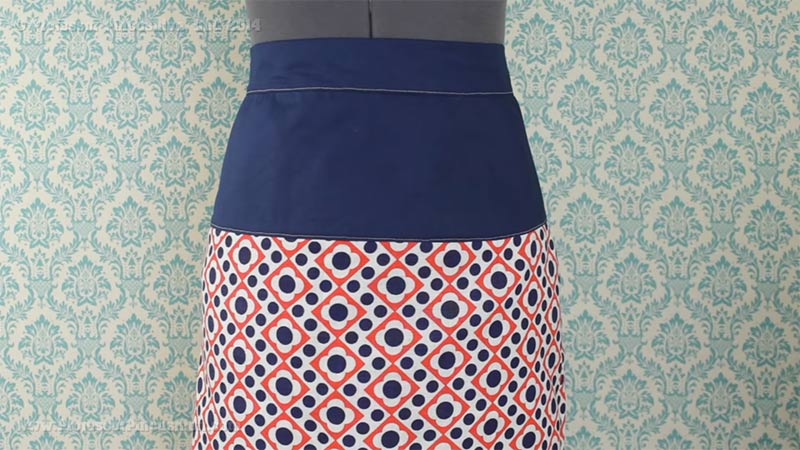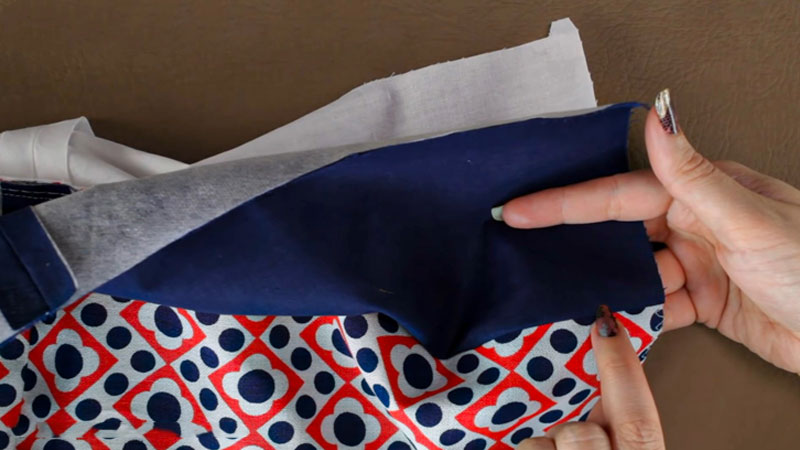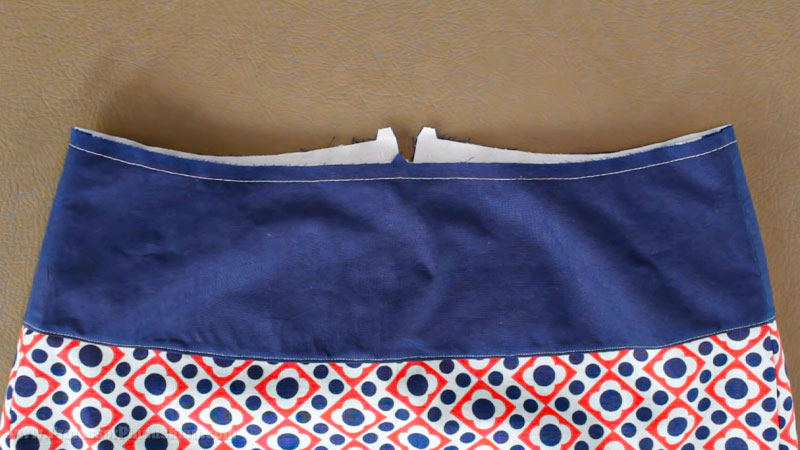Understanding the various components and techniques is essential for creating garments that seamlessly blend style and comfort in the intricate sewing world.
One such element that plays a crucial role in skirt construction is the “skirt yoke.” While seasoned seamstresses might be familiar with this term, those new to the craft may ask, “What is a skirt yoke in sewing?”
The skirt yoke is not merely a functional component but a design element that adds flair and structure to a skirt.
In this exploration of the sewing realm, we will unravel the mystery behind the skirt yoke, examining its purpose, variations, and the artistry of incorporating it into your creations.
Whether you’re a novice looking to enhance your sewing vocabulary or a skilled tailor seeking inspiration, join us on this journey to discover the skirt yoke’s significance in the garment construction world.

What Is A Skirt Yoke In Sewing?
In the intricate tapestry of sewing, the skirt yoke emerges as a fundamental yet often overlooked element, adding both structural integrity and aesthetic appeal to skirts.
As we delve into the depths of garment construction, let’s unravel the mysteries surrounding the skirt yoke.
Yoke Skirt Definition
In sewing terminology, a yoke is a shaped band that is typically fitted at the garment’s waistline, serving as a connecting element between the main body of the garment and other design features.
In the context of a skirt, the skirt yoke is a crucial component that contributes to the overall fit, style, and functionality.
Purpose of the Skirt Yoke
The primary purpose of a skirt yoke is to provide a smoother and more flattering fit around the waist. By distributing the fabric across the hips and waist, the yoke helps create a garment that looks aesthetically pleasing and feels comfortable to wear.
Additionally, the yoke can enhance the structural integrity of the skirt, preventing it from sagging or losing its shape over time.
Structural Variations
Skirt yokes come in various shapes and styles, each contributing to the overall design of the garment. Common variations include straight yokes, contoured yokes, and yokes with decorative detailing. The choice of yoke style depends on the desired look and the complexity of the overall design.
Tailoring and Fit

One of the key aspects of sewing involves achieving a tailored fit, and the skirt yoke plays a pivotal role in this pursuit.
Whether you’re crafting a pencil skirt, an A-line skirt, or a gathered skirt, the yoke allows for precision in fitting around the waist, ensuring the garment flatters the body’s natural curves.
Style Enhancements
Beyond functionality, the yoke waistband is a canvas for creative expression. Designers often use yokes as an opportunity to introduce contrasting fabrics, patterns, or embellishments.
This adds visual interest to the garment and allows for customization, making each creation unique.
Yoke Seam Placement
The placement of the yoke seam can significantly influence the overall appearance of the skirt. Higher yoke seams can create an illusion of an elongated torso, while lower yoke seams contribute to a more relaxed and casual look.
Seam placement is a strategic decision that designers make based on the desired silhouette and style.
Fabric Choices
The fabric choice for both the skirt and the yoke is crucial in achieving the desired look and feel. Lighter fabrics are often preferred for yokes, especially if they include gathers or pleats.
Experimenting with fabric textures and patterns can add depth and dimension to the yoke, making it a focal point of the garment.
What Are the Two Types of Yoke?
In garment construction, the term “yoke” refers to a shaped band of fabric that is strategically placed on a garment to achieve specific design and functional goals. Yokes come in various styles, each influencing the overall aesthetic and fit of the garment.
While there are numerous variations, two primary types of yokes are widely recognized: straight yokes and contoured yokes.
Straight Yokes: Classic Simplicity

A straight yoke is a simple and straightforward band of fabric that runs horizontally across the garment. It maintains a consistent width along its length, creating a clean and classic look. This yoke type is often used in various garments, including skirts, pants, and shirts.
Placement h4
Straight yokes are typically positioned at the waistline of a garment. In skirts, they can be found just below the waist, contributing to a smooth and tailored fit.
A straight yoke may be located at the shoulder level in shirts or blouses, providing structure and a clean line across the upper back.
Aesthetic Appeal
The simplicity of a straight yoke lends itself well to a timeless and versatile aesthetic. It is popular for those seeking a clean and polished finish without intricate design details.
Additionally, the straight lines of this yoke type make it adaptable to various fabrics and garment styles.
Use in Design
Designers often choose straight yokes when aiming for a more tailored and streamlined appearance. They provide a foundation for garments that require a defined structure around the waist or shoulders.
Straight yokes also serve as an excellent canvas for incorporating other design elements, such as contrasting fabrics or decorative stitching.
Contoured Yokes: Shaping for Fit and Style
A contoured yoke, as the name suggests, is shaped to follow the body’s natural curves. Unlike the uniform width of a straight yoke, a contoured yoke is narrower at the center and widens towards the outer edges, creating a more tailored and body-hugging fit.
Placement
Contoured yokes are commonly positioned at the waist of garments, such as skirts or pants. The shaping of the yoke complements the natural curve of the waist, providing a snug fit without sacrificing comfort. This type of yoke is particularly effective in achieving a flattering silhouette.
Aesthetic Appeal
The contoured yoke adds a level of sophistication and attention to detail to a garment. Closely following the body’s contours enhances the overall fit and contributes to a more refined and feminine appearance.
The shaping also allows for better ease of movement, making it a practical choice for various styles.
Use in Design
Designers often opt for contoured yokes when aiming to highlight the body’s natural curves. This type of yoke is favored in garments where a close fit around the waist is desired, such as in fitted skirts or tailored pants.
Contoured yokes can be incorporated into both casual and formal designs, offering versatility in styling.
Choosing Between Straight and Contoured Yokes
The choice between straight and contoured yokes depends on the garment’s desired aesthetic, fit, and functionality.
Straight yokes are excellent for achieving a classic and versatile look, while contoured yokes offer a more tailored and body-conscious silhouette.
Designers and sewers can experiment with both types to discover the nuances each brings to their creations, providing endless possibilities for expressing style and creativity in garment construction.
FAQs
Why is a skirt yoke important in sewing?
The skirt yoke is crucial in sewing for several reasons. Firstly, it provides a smoother and more flattering fit around the waist, contributing to the overall comfort of the garment.
Additionally, the yoke helps distribute fabric across the hips and waist, enhancing the structural integrity of the skirt. Beyond functionality, it serves as a canvas for creative expression, allowing designers and sewers to add visual interest and customize their creations.
What types of skirts commonly incorporate a yoke?
Various types of skirts can incorporate a yoke, adapting to different styles and designs. Pencil skirts often feature a yoke for a tailored fit around the waist, while A-line skirts use yokes to achieve a flattering silhouette.
How do you choose the right yoke style for a skirt?
Selecting the right yoke style depends on the skirt’s overall design and desired look. Straight yokes provide a classic and simple aesthetic, while contoured yokes offer a more tailored fit.
Designers often choose yoke styles based on the complexity of the design and whether they want to incorporate decorative elements. Consider the silhouette you aim to achieve and the visual impact you want the yoke to have on the final garment.
Can I add a yoke to an existing skirt pattern?
Yes, adding a yoke to an existing skirt pattern with some adaptation is possible. Carefully study the pattern instructions and determine where the yoke best fits the design.
Are there any tips for troubleshooting common yoke challenges?
If you encounter fitting issues with the yoke, consider making small adjustments to seam allowances or altering the yoke pattern. Mock fittings can help identify and address any problems before completing the final construction.
Conclusion
As we conclude our exploration into the realm of sewing, we’ve unveiled the significance of the skirt yoke as a versatile and artistic element in garment construction.
Far beyond its functional role in providing structure and fit, the skirt yoke opens up a realm of creative possibilities for designers and enthusiasts alike.
Whether you choose a classic yoke for a tailored look or experiment with asymmetrical or contrasting yokes for a touch of modernity, the key lies in understanding the yoke’s impact on the overall design.
By mastering the art of incorporating a skirt yoke into your projects, you empower yourself to transform simple pieces of fabric into stylish, personalized garments.
Leave a Reply